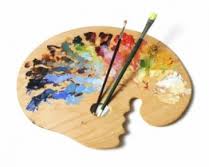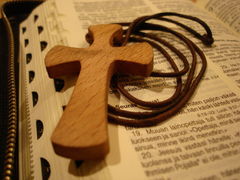———————————————————————————————————————
 Around 200 AD, color became a focal point in Christian art. In the beginning, each color’s meaning was taken from Ancient Greek and Roman interpretations, but soon the Bible became the color guide for Christian artists.
Around 200 AD, color became a focal point in Christian art. In the beginning, each color’s meaning was taken from Ancient Greek and Roman interpretations, but soon the Bible became the color guide for Christian artists.
When the Roman Catholic Church began using color to represent liturgical seasons, five were chosen as standard: purple, white, black, red, and green. Years later, blue and gold were added. Later on, two more colors joined the list: vibrant orange, which represented courage and strength, and rich brown, the symbol of earth and humility.
These key colors and their variants are apparent in surviving pieces of medieval Christian art and religious iconography.
● Purple, a royal color since ancient times, is also associated with repentance. It is the liturgical color for Lent and Advent.
● White symbolizes innocence, purity, and virtue. To this day it remains the representative color for all of the Christian high Holy Days, such as Christmas and Easter.
● Black is regarded as the symbol of death and mourning, although in some instances it could represent power. Black is the color associated with Good Friday.
● Red is the color of Pentecost and symbolizes the Holy Spirit. During the Medieval period it represented the blood of Christian martyrs.
● Green glorifies the season of Epiphany. It celebrates fertility, nature, bounty, and hope.
● Yellow (gold) symbolizes hope, light, and purity. When combined with white, it is the symbolic color for the Easter season.
● Blue embodies heavenly grace. The Virgin Mary is often depicted wearing blue.
 During the Middle Ages, color and light became important mediums for artistic expression. Color in particular was a vehicle for illustrating a higher reality, so shading was discouraged in favor of pure color. On canvas, human skin was not flesh-colored, but a pearly and ethereal white. Blood was a life-rich red, and skies and lakes were more cerulean than blue. Mixing paint became an art form in itself, as artists tried to reproduce the desired hues as clearly as possible.
During the Middle Ages, color and light became important mediums for artistic expression. Color in particular was a vehicle for illustrating a higher reality, so shading was discouraged in favor of pure color. On canvas, human skin was not flesh-colored, but a pearly and ethereal white. Blood was a life-rich red, and skies and lakes were more cerulean than blue. Mixing paint became an art form in itself, as artists tried to reproduce the desired hues as clearly as possible.
Although there was a system in place for color symbolism, it was not set in stone. Artists yielded to a natural impulse and added their own interpretations while paying lip service to the original standards. In the study halls and libraries, theologians and philosophers assigned additional meanings to each shade in the artists’ palette. It can make things confusing for modern art historians, especially when you take into consideration that the color symbolism of religious art found its way into secular art too. But a strong enough core system was in place to allow reasonable interpretation to be possible even today.
Read more Segmation blog posts about color symbolism:
The Stories Behind Holiday Colors
Colors Red and Purple: A History of Emotion
Be an Artist in 2 minutes with Segmation SegPlay® PC (see more details here)
Join us on FacebookSegPlay® Mobile iTunes now available for iPhone and iPad
Very informative and interesting. Hugs, Barbara